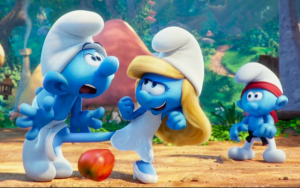Metro In Focus: Another generation gets ready to dive into a new blue world
 By Richard Crouse – Metro In Focus
By Richard Crouse – Metro In Focus
The all-animated Smurfs: The Lost Village aims to reintroduce the little blue creatures of Smurf Village to a new generation. It’s the first time more than one female Smurf exists in the community.
Featuring the voices of Demi Lovato, Joe Manganiello and Michelle Rodriguez, it trades on its inherent cute factor and nostalgia for much of its appeal. There are some good messages for kids woven in and the animation is relentlessly adorable but is there anything here for anyone over the age of five?
In what may be the most adult plotline in Smurf history, it’s a hero’s journey, a character’s search for purpose. It’s Joseph Conrad via Smurf Village. Smurfette’s Heart of Darkness.
As voiced by Lovato, Smurfette ponders her place in the world. All the other perky pint-sized blue creatures have descriptive names — Clumsy Smurf (Jack McBrayer), Jokey Smurf (Gabriel Iglasias) and Baker Smurf (Gordon Ramsey) — but what exactly, she wonders, is ‘ette’ supposed to mean?
Smurf aficionados will know she is the only female Smurf, created by wizard Gargamel to sow the seeds of jealousy in Smurf Village. With the help of Papa Smurf she became a beacon of sweetness-and-light and the love interest of Smurfs everywhere.
That’s quite a backstory and her quest for purpose is certainly noble, even if her beginnings weren’t. The character was first introduced in Franco-Belgian comics magazine Spirou in 1966 as a marketing tool. According to writer Hal Erickson the comely Smurfette was created as a means to “bow to merchandising dictates” and “appeal to little girl toy consumers.”
It worked and in the decades that followed Smurfette became the most sought after toy from Smurf Village.
The Smurfs are big business, in addition to this weekend’s big screen animated feature, the “three apples tall” characters have been translated into 30 languages (en français: Les Schtroumpfs, in Dutch: De Smurfen) to create an estimated worth of $4 billion, but not all Smurf related marketing has been successful.
Remember Smurf-Berry Crunch? At the height of 1980s Smurf mania Post Cereal released a sugary breakfast cereal they claimed tasted, “like crunchy Smurf Berries… In berry red and Smurfy blue.” To ensure the Smurfiest experience possible Post added little blue corn puff berries laden with food colouring to the mix.
Unfortunately the blue additives weren’t easily digestible by the body, leading alarmed parents to report cases of blue and strange coloured poop after breakfast time. According to poopreport.com, “when metabolized in sufficient quantity, the blue dye combines with bile,” to form a rainbow effect at potty time. The problem was fixed with the release of Smurf Magic Berries, which contained smurfberries made of yellow corn puffs and marshmallows.
For Jack Black Smurf-Berry Crunch also brings back some bad memories. The Kung Fu Panda actor remembers his second professional gig, a breakfast food commercial. “Being in a Smurf-Berry Crunch cereal ad and being pulled along in a red wagon…?” he says, too humiliated to finish the sentence. “My stock plummeted at school.”
I was a bit too cynical to buy into the North American Smurf craze of the 1980s — they were so popular one writer called them “kiddie cocaine” — but now in 2017 I see them as something other than an hour-and-a-half advertisement for Smurfs Are Us.
The new incarnation is a sweet kids movie designed for little ones but with just enough grown-up material to keep parents interested.
